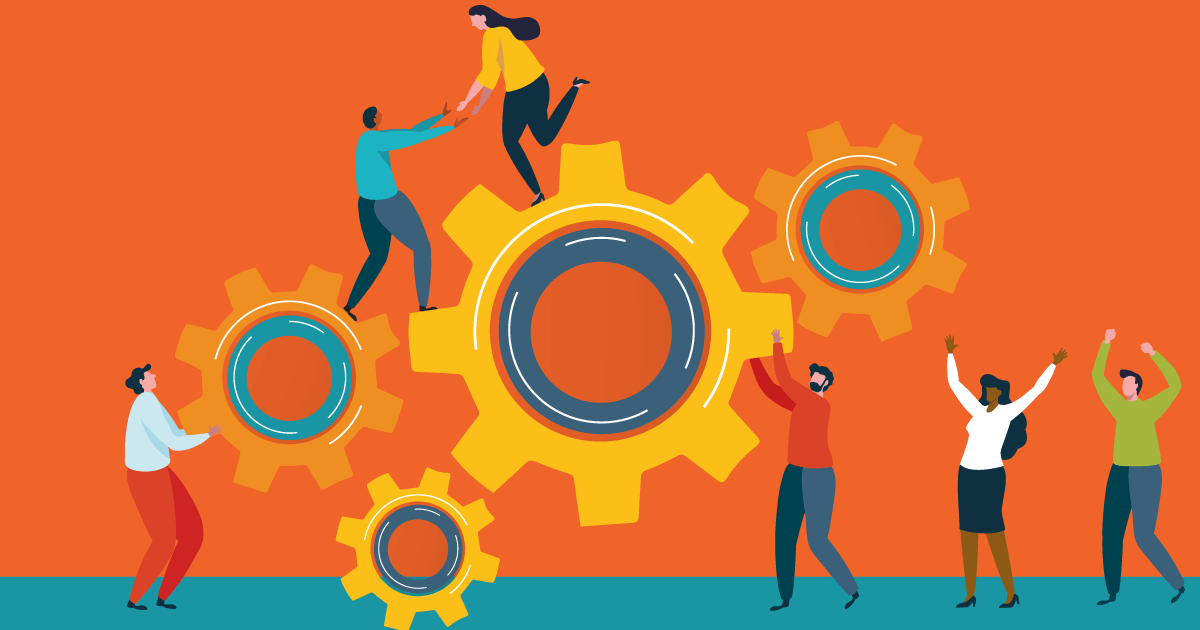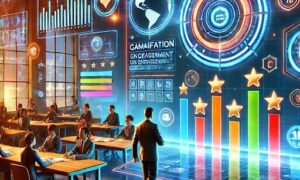The Great Resignation wave shifted conventional perceptions about work. With employees on a quest for work satisfaction and flexibility, employee experience has come to the forefront. Employees want to work for companies that help them learn, grow and care about them. Today, companies need to create a flexible, inclusive, and engaging work environment.
Driving employee engagement is still an ongoing challenge for many companies. It is tough to keep a distributed workforce motivated and productive. A workplace is a melting pot of cultures, demographics and personalities. The management needs to find innovative solutions to provide an all-inclusive employee experience. Improving employee experience drives employee engagement.
Gamification: Can it improve employee engagement?
Gamification is the usage of game-like elements such as scores and badges in a non-game environment. Workplace gamification is a concept that is gaining traction in the corporate world. Companies have realized that using gamification for employee engagement can significantly change the way employees see work. It can make work more interesting and gratifying for employees.
Workplace Gamification is all about employee motivation
A workplace is such an environment where employees are often asked to focus and be productive. Unfortunately, employees often lack the motivation to learn and accomplish more at work.
Gamification is a great solution to boost intrinsic motivation in employees. The competitive spirit drives employees to be more enthusiastic and engaged at work. Employees get more actively involved at work when they feel recognized and rewarded. If done right, gamifying dull aspects of a work can drive employee engagement and boost employee productivity.
But before developing a gamification strategy, organizations must closely analyze their objectives. The objectives of gamification must clearly lay out what the company aims to achieve. According to a gamification research survey, nearly 80% of workplace gamification efforts fail to meet a company’s objectives due to poor planning and design, and a lack of creativity and meaning. This failure costs many organizations to lose employee engagement and results in high turnover rates.
Hence, it is crucial to know what exactly motivates the employees. Workplace gamification must be goal-oriented and driven to attract employee engagement. The games must be personalized and must allow the user to get instant performance feedback. This can help employees improve themselves and learn from their mistakes.
Common Gamification techniques in the workplace
Many companies use game-like elements to drive employee engagement. Gamification is an enjoyable way to make progress in the workplace. The concept of gamification revolves around motivation and achievement. Some companies may use virtual platforms for gamification or even offline techniques to improve employee participation.
- The goal of using game-based elements in the workplace is to encourage employees to be at their productive best.
Some of the most common gamification techniques used by companies include:- Achievement badges or certificates
- Point-based rewards
- Leaderboards
- Incentives (Travel, cash, coupons, or exclusive benefits)
- Contests and friendly competitions
- Game-based learning
- Bonuses
Benefits of Workplace Gamification
Rewarding and recognizing employee achievements play a crucial role in employee loyalty. Gamification can pique the interest of the employee when it offers rewards that are truly worth working for. Research has revealed that gamification done effectively has many benefits:
- Increases employee interests and improves learning: Gamified learning is an interesting way to acquire knowledge. Most companies use gamification for employee engagement. Gamification can make employee training engaging. It aims to encourage employees to actively take part in work activities that may otherwise seem monotonous. With gamification, employees can work with a structured, goal-oriented strategy. Gamified learning is an interesting way to acquire knowledge. Employees tend to grasp faster and improve their performance.
- Recognizes good performance and enhances employee morale: Employees feel motivated when they are recognized for their achievements. Gamification encourages employees to keep progressing. It also helps them understand their own potential and brings out their best. Gamification is based on a system of achievement and rewards. Employees get motivated to put in their best when their work gives tangible returns.
- Retains and attracts top talent: Recent research shows that a gamified workspace increases employee happiness by 89%. Gamification aims to help employees achieve higher targets while having fun in the process. It helps employees grow by instilling genuine interest to update and upskill themselves. These interactive employee engagement programs make employees want to contribute more to their teams. The prospect of a gamified employee experience speaks a lot about a company’s work culture. It retains high-performing employees and talented candidates who want a flourishing career.
Three ways to Gamify Employee Engagement at the Workplace
Employee engagement is essential for the success of any team or an organization at large. Gamification at the workplace is all about devising creative ways to attract the attention of the employees. Gamification can be utilized in many ways. It can have a long-lasting impact on the employees and the work environment.
Here are some of the best ways to drive employee engagement in the workplace:
- Employee training and development
Gamification is being increasingly used in training. Most often, training sessions become lengthy meetings that are dull. According to Forbes, 60% of employees who undertook gamified training increased their productivity. Inserting game mechanics into the training process can energize the atmosphere. The drives competitive and active engagement. Workplace gamification is an effective tool to train new hires as well as current employees. Employees can learn about the company, workflow, products and so much more. With gamification, employee learning becomes easier. It also makes training sessions interactive and rewarding.
Gamified learning is especially useful for remote employee training. Gamifying training programs help companies to bring out a well-trained workforce. It reduces managerial responsibility and is an effective solution to integrating employees into the team. Gamified learning and development programs must be well-structured. Training modules can be shortened into modules or levels. As the employee progress through each level, badges can be given to acknowledge their successful completion.
Gamified learning gives employees a sense of accomplishment and motivates them to complete the training. Some of the most common gamification techniques include point-based quizzes and trivia. These techniques encourage employees to recall and apply their learnings. In this way, gamification helps in information retention. Use a motivation-based reward system like badges, certificates, scores and leaderboards to encourage employees.
One such company that chose gamification in training is Cisco. The company invested in a vast social media training program for its employees. But the program was quite unstructured and humongous. The company then incorporated gamification, simplifying the program into different certification levels. The program also included team collaboration challenges to foster an interesting competition.
- Team building activities
Team building is no longer a 5-minute ice-breaking activity or a one-time team luncheon. Building strong connections need well-planned team-building strategies. Many companies are investing in team-building activities to build social connections. Game-based team-building events have gained popularity. Friendly team-building contests not only help employees to have fun but also brings out employee talent. Employees get an opportunity to exhibit their leadership skills, communication skills, and creativity. Game-based team building also strengthens employee–employee relationships. Managers get to know their employees better.
Team building activities can be in a virtual or outdoor environment. It could be a game of volleyball or even a video game or a full-fledged company tournament. Employees get a space to explore their talents and be better acquainted with their colleagues at a personal level. Gamify team-building activities by rewarding the highest scorer, the best player, or the best team. This is a great way to recognize employees and boost employee morale. It makes them want to contribute to the team and work harder.
- Goal setting and work performance
Creating an environment of healthy competition can enhance business productivity. Set achievable goals and performance targets. A leaderboard can show the progress of employees. Offering good rewards for achieving targets can be a good motivation for employees. High-performing employees can be recognized based on their outcomes and rewarded. Recognizing good employee performance by awarding an ‘Employee of the Month’ title is a common practice. Even small gestures of recognition can go a long way in supporting valued employees. Some companies use performance monitoring and rewarding platforms to achieve goals.
Workplace Gamification: A boon if done right!
Using gamification for employee engagement improves productivity and profitability. But, incorporating gamification into business processes needs proper planning. It must be designed to motivate employees rather than discourage them. Employees must not feel pressurized or micro-managed. This can be counterproductive and lead to high attrition rates.
The gamification strategy should align with the goals of the team. Most of all, it should connect with employee motivation. Employees desire work that poses interesting challenges. The kind of work that intrigues them to learn, grow and eventually love what they do. Workplace gamification is a key strategy that can positively transform the employee experience. High business productivity is a result of employee satisfaction and motivation. An organization that can tap into both these aspects finds great success.



































